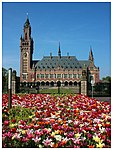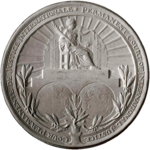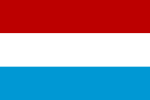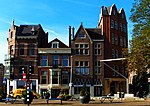The United Provinces of the Netherlands, also known as the United Provinces, officially as the Republic of the Seven United Netherlands (Dutch: Republiek der Zeven Verenigde Nederlanden), and commonly referred to in historiography as the Dutch Republic, was a federal republic which existed from 1588, during the Dutch Revolt, to 1795 (the Batavian Revolution). It was a predecessor state of the Netherlands and the first fully independent Dutch nation state.
The republic was established after seven Dutch provinces in the Spanish Netherlands revolted against rule by Spain. The provinces formed a mutual alliance against Spain in 1579 (the Union of Utrecht) and declared their independence in 1581 (the Act of Abjuration). It comprised Groningen, Frisia, Overijssel, Guelders, Utrecht, Holland and Zeeland.
Although the state was small and contained only around 1.5 million inhabitants, it controlled a worldwide network of seafaring trade routes. Through its trading companies, the Dutch East India Company (VOC) and the Dutch West India Company (GWC), it established a Dutch colonial empire. The income from this trade allowed the Dutch Republic to compete militarily against much larger countries. It amassed a huge fleet of 2,000 ships, initially larger than the fleets of England and France combined. Major conflicts were fought in the Eighty Years' War against Spain (from the foundation of the Dutch Republic until 1648), the Dutch–Portuguese War (1602–1663), four Anglo-Dutch Wars (3 against the Kingdom of England and a fourth against the Kingdom of Great Britain: 1652–1654, 1665–1667, 1672–1674 and 1780–1784), the Franco-Dutch War (1672–1678), and War of the Grand Alliance (1688–1697) against the Kingdom of France.
The republic was more tolerant of different religions and ideas than its contemporary states were, allowing freedom of thought to its residents. Artists flourished under this regime, including painters such as Rembrandt, Johannes Vermeer and many others. So did scientists, such as Hugo Grotius, Christiaan Huygens and Antonie van Leeuwenhoek. Because Dutch trade, science, military, and art were among the most acclaimed in the world during much of the 17th century, this period became known in Dutch history as the Dutch Golden Age.
The republic was a confederation of provinces each with a high degree of independence from the federal assembly, known as the States General. In the Peace of Westphalia (1648) the republic gained approximately 20% more territory, located outside the member provinces, which was ruled directly by the States General as Generality Lands. Each province was led by an official known as the stadtholder (Dutch for 'steward'); this office was nominally open to anyone, but most provinces appointed a member of the House of Orange. The position gradually became hereditary, with the Prince of Orange simultaneously holding most or all of the stadtholderships, making them effectively the head of state. This created tension between political factions: the Orangists favoured a powerful stadtholder, while the Republicans favoured a strong States General. The Republicans forced two Stadtholderless Periods, 1650–1672 and 1702–1747, with the latter causing national instability and the end of Great Power status.
Economic decline led to a period of political instability known as the Patriottentijd (1780–87). This unrest was temporarily suppressed by a Prussian invasion in support of the stadtholder. The French Revolution and subsequent War of the First Coalition caused these tensions to reignite. Following military defeat by France, the stadtholder was expelled in the Batavian Revolution of 1795. This ended the Dutch Republic; it was succeeded by the Batavian Republic.










